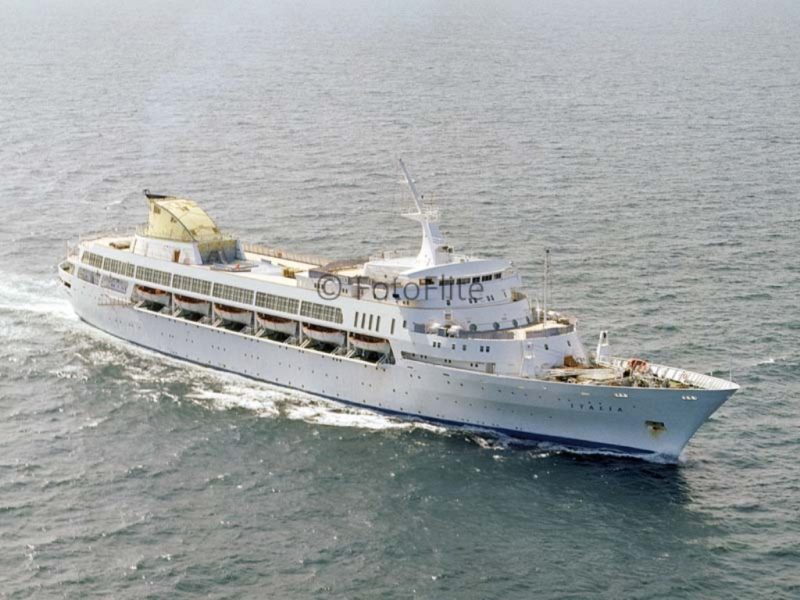
Precisely pinpointing the genesis of the modern cruise industry is an impossible task but a significant milestone can be traced to a collection of bespoke ships that emerged in the mid to late 1960s. Perhaps the greatest irony of this new fleet’s success is that it was dependent on a symbiotic relationship with the airlines. In effect the jet, the ocean liner’s nemesis and vanquisher, became the cruise ship‘s greatest ally.
One of the most impressive of this new breed of cruise ships was laid down at the Felszegi shipyard, Muggia on 23rd June 1963. These were the halcyon days of Italian post-war shipbuilding, and yard number 76 would become the final works of two of the era’s greatest exponents of external and internal ship design, Nicolò Costanzi and Gustavo Pulitzer Finali. The new ship certainly borrowed design elements from Costanzi’s other work, especially the Oceanic, then being built in the nearby Cantieri Riuniti dell’Adriatico (CRDA) yard at Monfalcone. Nevertheless she was also highly original, part of a generation that broke away entirely from the concept of the passenger ship as a means of transport, towards the notion of passenger ship as a holiday destination.
Italia was ordered by Sunsarda S.p.A, a subsidiary of the Giacomelli Group which also owned the shipyard amongst its diverse business interests. She was originally to be one of a pair and the intention from the start was to supply the expanding charter market, however despite the merits of her design she would endure a long and troubled gestation. Construction delays can be traced to several factors, a lack of skilled labour due in part to the demand from rival yards, a lack of and delays in supplying materials for similar reasons and arguably most significantly the owner and builders perilous financial position. Amongst the usual ceremony Italia was named and launched into the Adriatic on 20th April 1965, but when first the line and then the builders were declared insolvent, the incomplete hull was transferred to the largest creditor, Banca Nazionale del Lavoro (BNL).
BNL ultimately arranged for the ship to be completed, thereby securing the shipyard workforce’s short term future and established a new company, Crociere d’Oltremare, to manage the completion, operation and ultimately sale of the vessel. Plans for the second ship were quietly dropped. Thus it was four years and three months after the initial keel laying that Italia finally departed her builders for trials in the Gulf of Trieste.
At 12,219grt, the 149.78 metre long ship was small by modern standards. Her aft engines configuration created the archetypical cruise ship silhouette and there are clear similarities to Oceanic, arguably Costanzi‘s seminal design, with a heavily raked mast situated above the bridge, a large central lido and a funnel sited aft. The latter was located above a deckhouse that incorporated air-conditioning and ventilation machinery as well as the ship’s Gymnasium. Amongst the plethora of weird and wonderful stack designs proliferating from the world’s (and especially Italian) shipyards at that time, Italia’s was amongst the most unique. It actually almost defies description but ‘sculpted’ is perhaps the most accurate adjective. It is also the most appropriate because unlike Michelangelo and Raffaello, or even the Lloyd Triestino twins and Eugenio C, it was not designed by an aeronautical scientist but by a local Trieste sculptor, Ugo Carà.
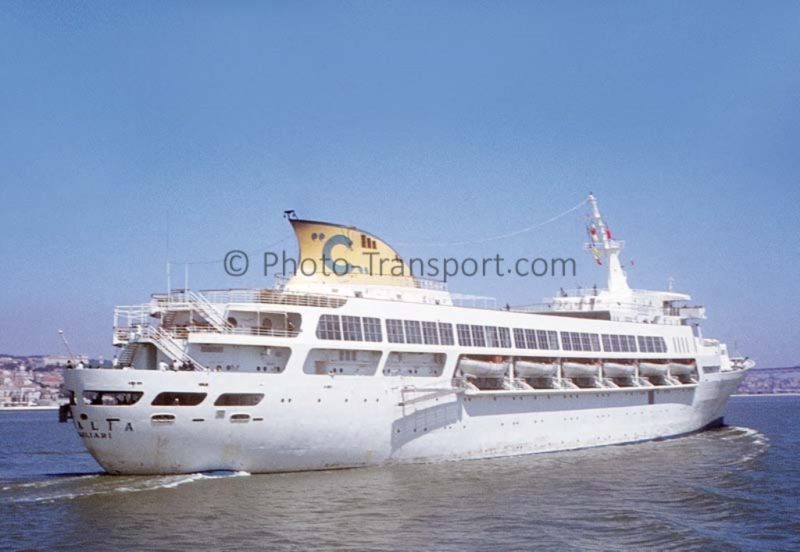
In the course of her trials the Italia’s twin, 14,800 HP nine cylinder Sulzer diesels, built under licence by CRDA, produced a top speed of 21.6 knots, well in excess of the contracted service speed of 19 knots. To everyone’s satisfaction she was handed over to her new owners on 11th September 1967 and prepared for the first of a series of three introductory cruises in the Mediterranean, under bareboat charter to Costa Line. The passengers who embarked at Trieste for that maiden cruise to Genoa, via Corfu, Valetta and Cagliari, were met by a ship that combined ‘old-school’ warmth and stunning modernity. Her hull might not have incorporated Costanzi’s trademark bow and stern features, but like the superstructure it maximised space for the cabin accommodation and public rooms.
There were eight passenger decks in all. The ship’s bridge, radio room and senior officer accommodation occupied the forward part of a high point superstructure ‘island’, with passenger access restricted to an area of teak covered deck space facing aft. This was called Sun Deck.
As the name suggests Lido deck provided a considerable area of teak lined sunbathing and outdoor recreation space, primarily occupying the central void between the island forward and the funnel housing aft. With the accompanying swimming pool and mosaic decorated surround just forward of the funnel (indeed the latter’s broad, forward facing slope, almost seemed to have been installed as a tempting waterslide), this was the main focal point for languid days at sea, sunbathing and the occasional ‘dip’. The forward section of both this and Riviera deck below consisted of a stepped arrangement. It provided a full ‘wrap around’ deck with a viewing vantage point forward below the bridge and additional deck space around and aft of the funnel. Servicing the Lido and providing respite from the sun during the day and a favoured evening waterhole was the Veranda bar. With it’s patterned carpet, stripped light panels and angular chairs this was an informal haven and occupied the aft portion of the forward superstructure island, opening out towards the lido and pool. Officers accommodation occupied the forward part.
Riviera deck was initially entirely devoted to public rooms, the main location for evening entertainment and a daytime repose. Early in her career cabins were added forward of the Observation Lounge and early in her subsequent Costa career the lounge itself was replaced by additional cabins. Heading aft an impressive central lobby was bracketed by a small boutique/gift shop, the card room, which was also used as a chapel when required, and games room on the port side, and toilet facilities to starboard. A passage between the central lifts and stairwell opened into the Grand Salon. Designed by Romano Boica who also worked on Guglielmo Marconi, Raffaello and Oceanic, the Grand Salon was an extremely spacious full width room with light flooding in from floor to ceiling windows. There was an interesting ‘staggered’ bar arrangement discretely hidden on the starboard side and a large central dance floor. High backed, brown chairs predominated, their angular head and arm rests fitted in well with the squared off pillars and linear ceiling panels. No doubt the chairs were fashionable at the time but looking now are somewhat reminiscent of a care home environment. Further aft was another lounge which doubled as a nightclub, with Finali’s unmistakable touch. His signature circular ceiling patterns and light fixtures were echoed in the oversized circular ‘portholes’ that provided a modicum of daylight to the the room (echoed in the forward facing bulkhead on this deck). Gold lacquered pillars and ceiling panels, grey stone coloured carpet and blue velour fabric chairs created the luxurious, Genoese richness the designer was famed for. This room also had a large bar, central dance floor and a bandstand situated adjacent to the far aft bulkhead. It was surrounded by a part enclosed and part exposed promenade area.
Promenade deck extended the full length of the ship and as the name suggests nominally provided an encircling outer deck space. In some ways though it was a misnomer. Six lifeboats lined each flank, stowed inboard in recessed housings akin to Canberra and Oceanic. However unlike those other ships the lifeboats were stored at near deck level on davits extended on sponsons, so strollers had to walk along a narrow inboard passage, rather than under the boats. At the forward end was the open mooring deck and the location of two cranes to serve the solitary forward hold. An assortment of cabins occupied the forward portion of this deck including the highest category nine Deluxe Suites. They must have been rather gloomy being located between and looking out at the foremost pairs of lifeboats. These suites included twin beds, a separate sitting area, tub bath and a shower. In fact all of the 213 cabins could be reasonably categorised as luxurious, irrespective of price and location as they had ensuite facilities, individually controlled air conditioning, a private telephone, closed circuit TV set and two channel radio. Returning to Promenade deck and sandwiched fore and aft between the central and aft stairwells (akin to the Grand Salon above) and the remaining lifeboats along each side, was the Dining Salon. This impressive room included a recessed central ceiling section, with back-lit illuminated glass panelling that ran the length of the room, flanked by circular columns. The aft section of Promenade deck, with a narrow walkway surround, was given over to the galley.
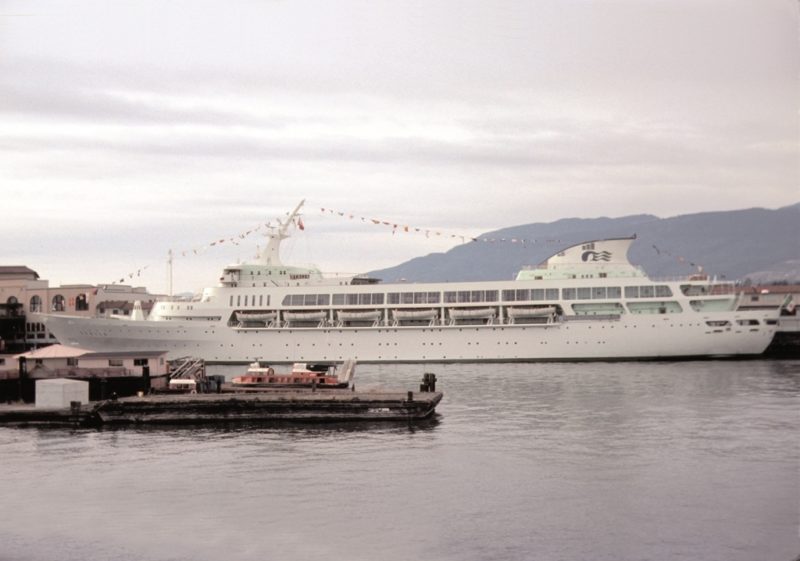

Pacific deck was the main embarkation point for the ship, with shell doors amidships leading into the Main lobby with a front desk for the Pursers Office, the hair dresser, barber and phone operator radiating off. There was also an aft set of shell doors which opened into the aft stairwell and lift lobby area. Cabins for passengers were arranged centrally between the forward, mid and aft stairwells all of which had two adjacent lifts. Apart from the hospital and doctor’s consulting room just aft on the starboard side, the rest of the deck consisted of crew accommodation and working areas.
Down one flight Belvedere deck replicated Pacific deck’s basic layout with passenger cabins central and crew at each extreme. Capri deck followed the same pattern but access to Cinema deck, lowest of the passenger decks was restricted to the capacious and comprehensively equipped cinema/theatre. The television station was also operated from an ante room next to the Theatre.
The total initial passenger capacity was 425 but this was based on the use of several Pullman type upper berths that in practice were rarely utilised. Looking after them all was a crew of 252. Sporting Crociere d’Oltremare’s hastily concocted funnel livery, primarily white but with a central motif comprising yellow and red triangles that mirrored the funnels curvature, Italia received rave reviews on the initial voyages and quickly attracted the interest of industry newcomers Princess Cruises, whose founder Stanley McDonald had recently started offering Mexican Riviera cruises aboard the veteran Princess Patricia. With no planned itineraries of their own, Costa negotiated a sub-charter to Princess, and on 12th November 1967 she departed Trieste for Los Angeles. Just over a month later on 15th December Italia departed from the Californian port, taking over the American company’s Mexican cruise programme. Unlike her predecessor on the service passengers could be assured of a comfortable cruise experience, with air conditioning throughout and stabilisers to iron out those Pacific swells. Although marketed as Princess Italia her hull name was never changed and she also retained Crociere d’Oltremare’s funnel livery throughout the following year. The success of Italia’s programme prompted Princess to charter Costa’s larger, recently acquired Carla C, formerly the French Line’s Flandre, to take over the itinerary for the following winter season. Carla C was the first ship to sport the ‘Sea Witch’ company logo on her funnel and almost exactly a year after Italia had pioneered the service, on 19th December 1968 took over the schedule from Los Angeles. Italia soon adopted the same funnel motif and the following summer found herself inaugurating another pioneering cruise schedule, sailing on 3rd June 1969 from San Francisco to Alaska. That year she also made a solitary cruise to Australia however due to a general lack of support it was not repeated.
For four more years Italia would operate under the Princess banner, helping the company to expand until Britain’s P&O, seeing the potential in the Love Boat’s Pacific coast operation acquired the company in 1974. By then the Princess Italia’s charter had been terminated, reverting to Costa in October 1973 and a refit that included upgrading and refurbishment her interiors and the addition of some new passenger cabins. She also adopted Costa’s yellow funnel with its large blue C and punctuation marks for the first time.
On Friday 1st February 1974 Italia cast off from San Juan at about 7pm on her first Costa cruise, a 10 night, port intensive voyage to St. Thomas, Antigua, Guadeloupe, Barbados, Caracas, Aruba and Santo Domingo, before returning to Puerto Rico. The following cruise was one night longer and incorporated an additional call at Cartagena and an extra sea day. These longer cruises were however the exception, Italia’s main employment was on 7 night cruises in the Eastern Caribbean, the most numerous of which called at Curaçao, Caracas, Trinidad, Martinique and St. Thomas. She was advertised as being “A big and beautiful ship for special people. Like you”. Italia attracted a loyal following. Ironically given the marketing slogan passengers were often drawn by her compact size but also excellent facilities and Italian service. The general impression is that she seemed bigger than she actually was, especially the spacious Lido.
Costa decided to relocate their turnaround port to Port Everglades from December 1974, with 7 to 11 day cruises now extended to 10 to 14 days, but otherwise Italia continued to offer a similar cycle of Caribbean itineraries, periodically interspersed with longer ventures into South American waters. After ten years, in 1977 Crociere d’Oltremare finally realised the last element of BNL’s plan when they sold Italia to Costa Line. Her new owners employed her on a broad variety of cruise schedules over the following six years, she was seen all over the world from the Amazon to Australia (this time under charter to Neckermann Reisen), from Patagonia to Patras. Although she was primarily employed in the Mediterranean even these ranged from 7 night circuits out of Venice to 22 night adventures into the Black Sea. Sometimes she sailed for Costa, sometimes under charter to tour operators.
In the early 1980s, under new management following a transfer to public ownership Costa commenced a fleet rebuilding programme. Consideration was given to lengthening Italia in 1982 but in the end the project was abandoned as too expensive. The following year she was placed on the sales list and acquired by a new Greek operator called Ocean Cruise Lines. As cruise ships were growing ever larger they wanted to exploit a perceived gap in the market by operating smaller ships on itineraries that incorporated ports unsuitable for the new breed of mega-ships. Italia was renamed Ocean Princess and on 24th September 1983 arrived at Piraeus, before moving to a shipyard in Perama for an extensive refit planned by architect Michael Katzourakis. Externally apart from adopting Ocean Cruise Line’s attractive funnel livery (deep yellow with a slim white band topped by black and a stylised white O symbol), the most notable difference was the addition of glazed screening along each flank. This made a significant difference protecting the previously exposed Sun and Lido deck areas. The floor to ceiling windows on each side of the Grand Salon were also reconfigured with broader pillars.
Internally the original 1960s décor was jettisoned in favour of 1980s chrome, brushed steel and brass, with vibrant colours and harsh lighting. The veranda bar on Lido deck was enlarged and renamed Café de Paris, passenger cabins replacing the officers accommodation. On Riviera deck to port the main vestibule/lobby and adjacent rooms were reconfigured so the former games room and card room/chapel became the Monte Carlo casino. Although the deck nomenclature remained unchanged the public rooms were all renamed, so the Grand Salon became the Marco Polo Lounge, the aft lounge/nightclub became the Raffles Piano bar and Discotheque and the dining room became the Four Seasons Restaurant.
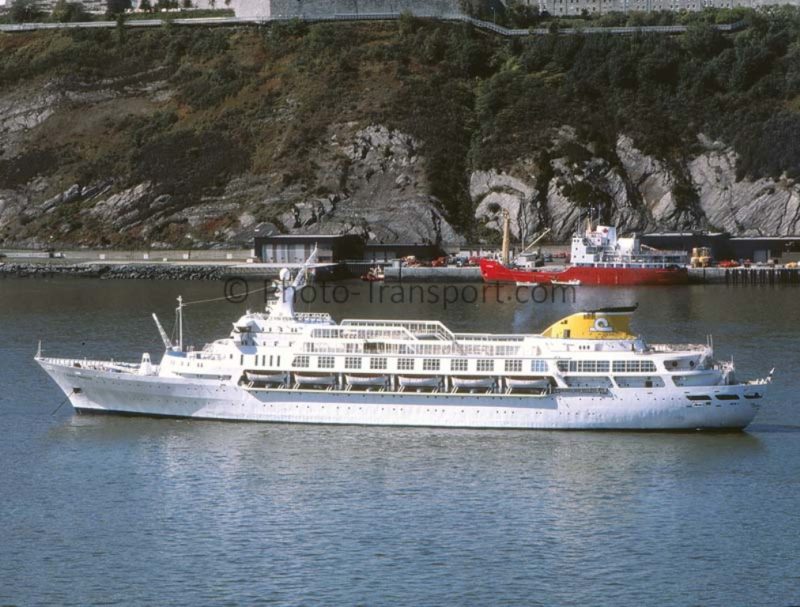
Sticking to the Mediterranean or Northern Europe in the northern hemisphere summer, she would then reposition to the Caribbean and/or Latin America for the winter. Ocean Princess settled quickly into a pattern that would sustain her over the next decade. Her new fleet mate was another distinguished former Italian vessel, the rebuilt Adriatica liner San Giorgio which was renamed Ocean Islander. At some point in her Ocean Cruise Line career the existing foredeck cranes were removed and replaced by a single, modern crane, similar to the transformation effected on QE2. The new crane was specifically installed to manoeuvre a pair of launches which were lodged on the foredeck, expressly to aid with tendering in anchor ports. In 1990 Ocean Cruise Line was purchased by Argimar SA, and operated by a fellow subsidiary of parent company Accor and Chargeurs, Paquet cruises. Under the terms of the sale only Ocean Princess was retained and she continued to fulfil her advertised schedule, although now sporting Paquet’s white funnel, with Oceans stylised O in blue.
In all her various guises Italia/Ocean Princess had found a niche by offering cruises to novel locations, beyond the realms of larger cruise ships. Inevitably this could also put her at greater risk when manoeuvring in confined ports and anchorages and alas on 1st March 1993, during one of her very popular ventures up the Amazon, she struck an uncharted submerged wreck at Belem and was holed below the waterline. The ingress of water couldn’t be controlled by the ship’s pumps and she sank, although fortunately it was on an even keel. Whilst there was no loss of life the engine room and lower decks were all flooded. Three weeks later, on 20th March, after patches had been applied to the hull the ship was refloated and moved to a Brazilian Naval berth for inspection. The damage was more considerable than originally believed and assessors declared her to be a Total Constructive Loss. In early April the Insurers sold the ship to Ellice Marine, a Greek company based in Athens and she was taken in tow on 15th April for the long voyage to Keratsini near Piraeus, for repairs and refurbishment. In July 1993 she was re-registered under the ownership of Equinox Enterprises S.A., a subsidiary of the Tranos A.M. Bartsokas J.N. shipping group. Trading as Sunshine Cruise Line the new owners changed the ship;s name (and sex!) to Sea Prince, with the intention of using their new acquisition on week long Aegean cruises. The refurbishment at Keratsini continued through 1994 and into 1995, but as it neared completion on 26th May the nearly completed ship was gutted by fire. Although the blaze was eventually brought under control the damage was so extensive that her owners felt there was no option but to put Sea Prince back on the market.
She was sold for $9 million in September 1995 to the Cypriot registered Louis Cruise Line, a branch of the Louis Group that held diverse travel and tourism interests. They had built a successful Mediterranean operation using veteran cruise ships and liners and the former Italia neatly fitted their requirements. She was renamed Princesa Oceanica but before the intended refit was started Louis entered a charter agreement with the British Thompson travel group, which injected further capital towards her refurbishment. More than six months and $5 million later the newly re-christened Sapphire emerged from the Perama shipyard, sporting an extension to her forward superstructure on Riviera and Promenade deck which contained additional cabins. Otherwise a comparison of the deck plan for Sapphire in the early 1990s and that of Italia in the late 1960s shows relatively little difference. Naturally furniture and fittings had been altered to reflect changes in taste and fashion but little had structurally changed, testimony indeed to the skill of Costanzi three decades earlier.
Sapphire endured a troubled start. Although her maiden voyage on 3rd April 1996 passed off untroubled she suffered a complete engine breakdown on her subsequent cruise. After repairs had been effected she returned to service in July, operating a Western Mediterranean itinerary in the summer months and Eastern Mediterranean cruises from Limassol over the winter. When the Thompson charter expired in 2002 and was not renewed she was absorbed into the Louis fleet, providing a further eight years service to her Cypriot owners. Like so many contemporaries the introduction of stringent SOLAS regulations in 2010 ultimately proved her undoing. Despite her timeless silhouette there were more modern, efficient and therefore profitable ships being introduced by Louis and rebuilding her to conform with the new regulations simply wasn‘t a viable option. She was withdrawn from service at the end of 2010 but it wasn’t until 2012 that she followed the one way pilgrimage to the breakers running up on the toxic sands of Alang. Ironically her final voyage was made under the rather upbeat name of Aspire. By the end of the year she was gone.
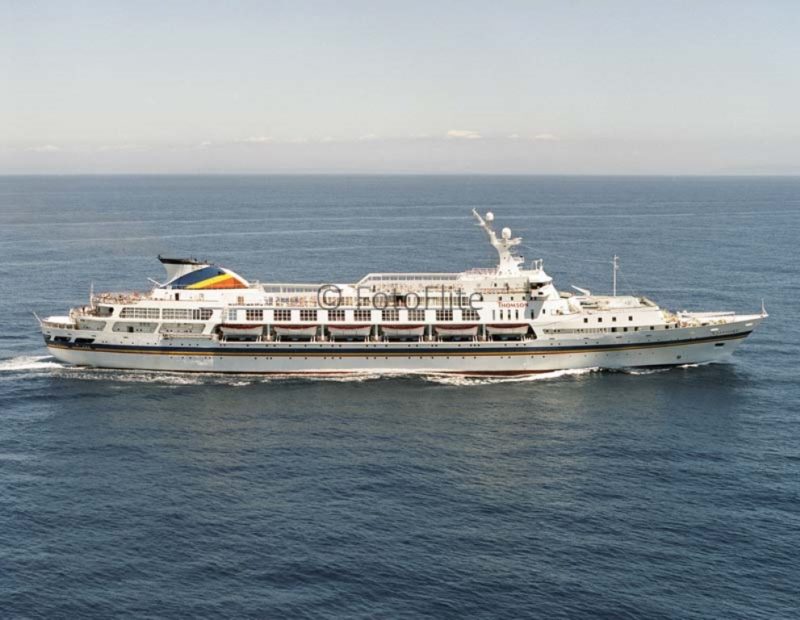

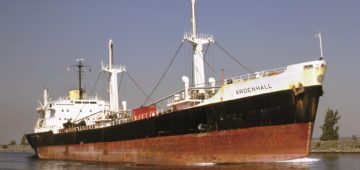



Comments
Sorry, comments are closed for this item